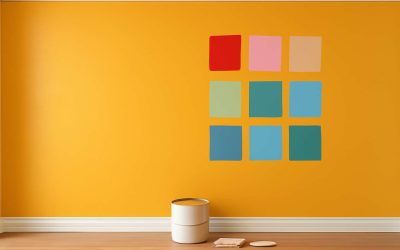The wide selection of interior paints at home improvement centers and hardware stores can be overwhelming, but choosing the right type for a specific room or project will greatly improve the results. There are different sheens to choose from as well as a variety of paint formulations, including low- and no-VOC options. The type of paint you select depends on the amount of wear and tear the space will endure.
Durability: The more traffic a room receives, the more wear and tear it will see. For high-traffic areas, choose a scrubbable paint that can be easily removed with a damp sponge to remove marks and scuffs. The sheen also has an impact on how easily a surface can be cleaned. Flat or matte paints offer non-reflective surfaces that hide surface blemishes like nail holes and other imperfections. Eggshell and satin are shinier options that are easier to clean than flat, but not as easy as gloss paint.
Lightness: A room’s lighting can drastically affect how a color looks, so it’s important to test a few shades against the existing wall before making a final decision. Lighter colors can make small spaces feel larger and brighter, while darker hues can create cozy, intimate areas.
Texture: The sheen and texture of a paint can have an impact on how easy it is to clean, as well as how much light it reflects. Flat or matte paints are the easiest to keep looking fresh, as they hide surface blemishes and require less coats than glossy options. Semi-gloss paint is a good middle-ground, as it’s not as shiny as gloss but easier to clean than eggshell. Gloss is the most reflective, and therefore the hardest to keep clean, but can work in some spaces.
VOCs: Volatile organic compounds are chemicals that wet paint emits into the air. The less of these chemicals a paint contains, the better for the environment and your health. Low and no-VOC paints reduce unhealthy off-gassing while still offering the same performance as traditional options.
Color: Finally, when it comes to choosing a color, consider the age of any children in your home. Younger kids may prefer more vibrant and energetic hues, while older children might want to opt for softer or neutral tones.
Before you head to the store, prep the space you’re painting. Clean walls, patch any cracks or chips and sand rough spots. Prime the area before applying a coat of paint, and use masking tape to protect adjacent surfaces. Then apply your chosen hue with a brush or roller and allow it to dry before adding more coats. Be sure to test the colors in natural light, as they can look different under artificial illumination, and be sure to wait for any moisture to evaporate before applying a second coat. If you’re not sure how to get started, contact your local painting contractor for advice or assistance. They’ll be able to help you pick the right product and get the job done quickly, safely and with excellent results.



0 Comments